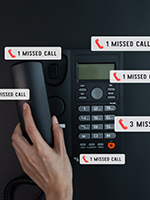How to Spot the Red Flags That Your Phone System Is Holding You Back—and What to Do About It
Signs your business has outgrown its phone system
As your company grows and evolves, so do your communication needs, but many businesses don’t realize their phone systems are lagging behind until it starts costing them time, money, and customer satisfaction. Spotting the signs your business has outgrown its phone system is crucial to maintaining productivity, supporting remote work, and delivering a seamless customer experience. From dropped calls and limited scalability to outdated features that can’t keep up with today’s hybrid workflows, an aging phone setup can quickly become more of a burden than a benefit. In this post, we’ll walk through the most common red flags that your current phone solution isn’t serving you anymore, and offer practical guidance on how to make a smooth transition to something more modern, flexible, and future-ready.
Here are common signs that a phone system may no longer be meeting the demands of a modern business, along with practical strategies to address them.
1. You’re Hiring, but Your System Isn’t Scaling

Why it matters:
As teams expand, especially across departments, offices, or time zones, a phone system that doesn’t scale easily can become a serious obstacle. Physical infrastructure limitations, licensing costs, or the inability to quickly onboard new users can stall momentum.
What to do:
Look for solutions that support elastic scaling. Cloud-based systems or hybrid platforms often allow for adding users, lines, or features with minimal configuration and no physical rewiring. This not only reduces costs but enables fast response to changing business needs.
2. Customers Are Waiting Too Long or Getting Lost in the Shuffle

Why it matters:
Long hold times, repeated transfers, or reaching the wrong person frustrate customers and harm credibility. A poorly structured call flow doesn’t just reflect inefficiency, it risks losing business.
What to do:
Prioritize features like interactive voice response (IVR), call queues, and intelligent routing that ensure each caller is guided to the right destination efficiently. These tools not only reduce manual handling but enhance the overall experience by offering options tailored to the caller’s needs.
3. Your Team Works in More Places Than Your System Does

Why it matters:
As remote work, satellite offices, and field teams become more common, a location-bound phone system can create communication gaps. Employees should be reachable, regardless of where they’re working.
What to do:
Adopt a platform that supports mobile and desktop softphones, browser-based calling, or app integrations. These features empower users to stay connected to the business line without being tethered to a desk phone, maintaining professionalism and responsiveness on the go.
4. IT Is Constantly Troubleshooting Basic Tasks

Why it matters:
A phone system that requires frequent technical intervention drains internal resources and delays simple updates like changing a voicemail greeting or adding a new user.
What to do:
Consider systems with intuitive administrative portals that allow authorized staff to manage settings without needing deep technical knowledge. This decentralizes control and improves operational agility.
5. Calls Are Being Missed and So Are Opportunities

Why it matters:
Every unanswered call could be a missed sale, support request, or partnership. If a system lacks proper handling for call overflow, out-of-hours routing, or voicemail visibility, customers may not try calling again.
What to do:
Implement smart call handling features like simultaneous ringing across devices, voicemail-to-email, and after-hours routing. These help ensure no message goes unheard and no opportunity is missed.
6. You’re Operating Without Call Insights

Why it matters:
Without access to call data, such as average hold times, call durations, or drop rates, it’s difficult to improve service, identify training needs, or align staffing with demand.
What to do:
Use systems that include built-in analytics dashboards. Real-time and historical reports allow decision-makers to monitor performance, spot trends, and take proactive steps to improve communication workflows.
7. Concerns About Reliability or Security Are Mounting

Why it matters:
Outages, call quality issues, or security vulnerabilities can severely damage trust. In sectors like healthcare, legal, or finance, the risks of non-compliance or data breaches are even greater.
What to do:
Prioritize providers that offer high uptime guarantees, geo-redundant infrastructure, and end-to-end encryption. Security and reliability should be baked into the system, not added on as an afterthought.
Time for a Communications Check-Up?
If any of these issues sound familiar, it may be time to reassess your current setup. A modern phone system isn’t just a communication tool, it’s a critical part of customer experience, team productivity, and operational efficiency. Upgrading doesn’t always mean starting from scratch. Many solutions integrate with existing tools, offer phased rollouts, or provide hybrid options that balance innovation with continuity.
Need help identifying the right path forward?

Signs your business has outgrown its phone system
Start by evaluating your team’s current needs, your growth goals, and the expectations of your callers. With the right technology and a clear plan, you can ensure your phone system supports, not hinders, your next stage of success.
